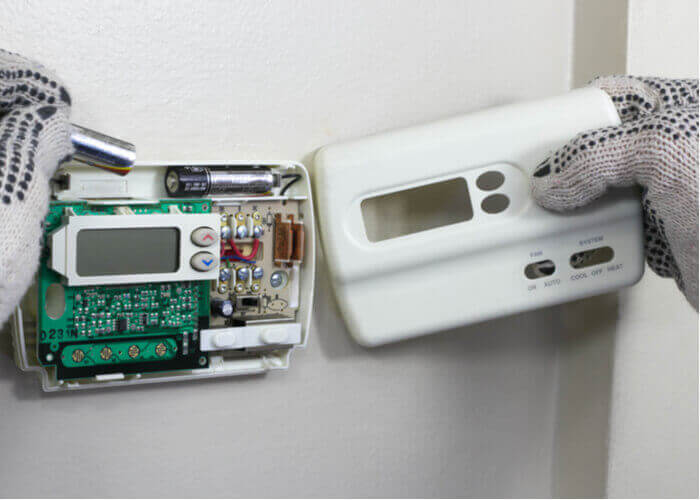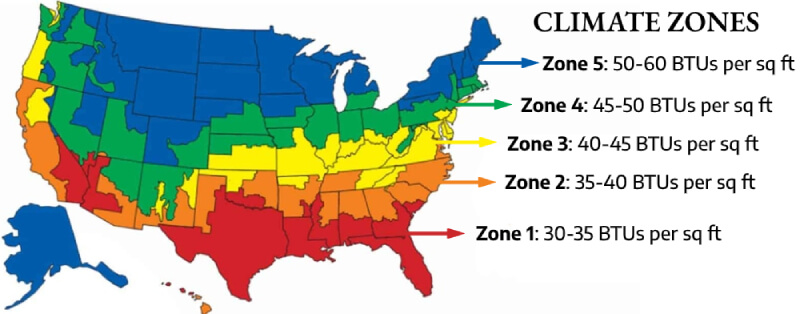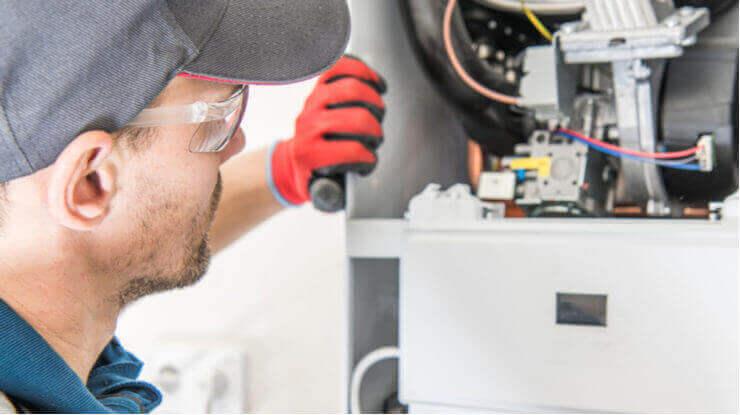An annual furnace tune up is part of maintaining your natural gas heating system. Maintaining your furnace can save you a great deal of time and money. Because emergency furnace repairs can be costly and inconvenient, especially around the holidays and during the winter.
What can you do to better maintain your gas furnace heating system? How can you improve the energy efficiency of your heater? And, finally, what is covered in a professional furnace tune up?
By the end of this short read, you’re going to learn the answers to these questions and more.
What are the Steps for DIY Furnace Maintenance?
Most homeowners are like I was. They don’t pay attention to their heating system unless there’s a need for replacement or furnace repairs.
So here are some simple steps for DIY furnace maintenance. These are things that can extend the lifespan of your heating system and increase the energy efficiency of your natural gas furnace.
Replace your Air Filter
Dirty air filters are the number one cause of furnace problems.
If your air filter gets clogged, it will impact your heating system’s air intake. That can cause the heat exchanger in your heating system to overheat and shut off automatically.
If you notice that the blower is running but you don’t have heat? It’s could be your dirty air filter tripped the shut-off.
A dirty air filter can also cause soot buildup on the heat exchanger, since the natural gas isn’t burning efficiently.
And lastly, a furnace that isn’t burning efficiently has the risk of generating carbon dioxide, a byproduct of gas that isn’t fully burning.
At a minimum, change your furnace system air filter every 90 days.
Many furnace repair experts warn against the heavy-duty allergen filters as causing too much of a strain on your system. Your better approach is to buy an inexpensive air filter and change it monthly. Then buy a stand-alone air filter system to allergens from the air.
Replace the Battery in Your Thermostat
Some thermostats are hard-wired to your home’s electrical system. But if your thermostat is battery operated, replace the batteries once a year. (While you’re at it, replace the batteries in your carbon dioxide detector, smoke alarms and fire alarms.)
If your thermostat isn’t operating, your furnace will not run.

Check the Exhaust Flue
Your natural gas furnace vents gasses out of your home through a flue pipe. If you have a fireplace in your home, your furnace exhaust pipe may run out of the top of your chimney. Otherwise, it will be one of the vent pipes exiting your home on the roof.
If your furnace exhaust pipe does not have a cover to keep out birds, it’s possible that one made your home its home during the off-season for heating.
Check the exhaust flue pipe for debris before each heating season.
Flush the Furnace Drain Line
If you have a high-efficiency furnace — one with two heat exchangers instead of one — your furnace will generate several gallons of water a day during winter heating season.
Water is created naturally through the heating process in your furnace. When natural gas burns, it produces carbon dioxide and water as a bi-product.
This water should drain out of your HVAC system through the drain lines — the same lines that drip water from your central A/C.
But if the drain lines in your system become clogged, it can create a back-up in your system. You’ll come home to leaks in your ceiling or worse, leaks inside the walls that you don’t see until it’s too late.
Check the drain hose on your furnace. If the hose looks dirty, you can flush it with a mixture of 1 part bleach to 3 parts water.
Clean your Air Ducts
Your heating system uses vents and air ducts to supply your home with warmth during the colder seasons, and comfort during the warmer seasons. Both cooling and heating systems use these ducts for air conditioning.
When ducts and vents aren’t clean, however, they can pose a health and safety risk to the people inside the home. Dirty ducts can increase the amount of allergens present in the air. It could make your HVAC system work harder than it normally should.
With a damp cloth, clean the grills and wipe around the duct’s entrance and as far as your hand can reach. Every once in a while, take the cover off your vents and use a vacuum cleaner to remove dust (or hire a professional duct work cleaning company).
Check the Ductwork for Leaks
The ductwork in your heating system will likely be in your attic. During the winter heating season, your attic should be cold. Insulation on the floor of your attic insulates your home’s interior from the outside.
With the heater running, check to see if your attic is warm. If so, you have a problem with leaks in your ductwork. Leaky ductwork could also be the issue if one of the rooms is colder than the others.
If you find holes in the ductwork or separations between ductwork sections, seal any gaps with special metal foil HVAC duct tape.
Never use regular duct tape on ductwork! We know, crazy. But the adhesive on duct tape can’t withstand the changes in temperature that your attic endures.
Do a DIY Home Audit to Seal Leaks
During colder months, your furnace works extra hard to provide your home with warmth. The least you can do is to lighten its load.
Do a quick DIY home energy audit to find out where you are losing heat from your home.
Check your ducts, insulation, windows, and anywhere else the cold winter air could seep into your home. Sealing your windows and prepping your home for the colder months not only makes your home more comfortable; it also helps your furnace run more efficiently.
And, make sure you are using the best thermostat settings for winter so your furnace runs efficiently. Try for 68* when you are home during the day, 60* when you are away, and 65* at night.
Lower Your Winter Heating Bill
Get the DIY Home Energy Audit download plus our energy savings newsletter.
"*" indicates required fields
What’s Included in a Professional Furnace Inspection and Heating Tune Up? (And how to know if you need one.)
In addition to your DIY furnace maintenance, you should also have a furnace inspection and professional heating tune up once a year. That’s especially true if you have a natural gas furnace.
Why? Because while natural gas is the most cost-efficient way to heat your home, it can also produce carbon dioxide. So a leak in your furnace could be causing a health hazard in your home. Plus, a furnace inspection and tune up helps your furnace run more efficiently.
You need a professional heating tune-up if you are not comfortable with checking electrical connections or working with mechanical parts.
Here’s what’s typically included in a heating tune up:
- Lubricate motor bearings and other moving parts
- Check and adjust fan belt tension
- Voltage and current checks
- Tighten all electrical connections
- Inspect heat exchanger and burners
- Check and test safety controls
- Test exhaust system
- Check air flow across all registers
- Inspect and clean burner
- Verify and adjust gas pressure
- Test ignition system
- Check and adjust pilot light operation
- Check connections to gas lines
- Test and verify system controls
- Check duct work
- Inspect condensate drain and clear, if needed
- Clean interior and exterior of the furnace
- Test carbon monoxide levels
- Inspect and calibrate the thermostat
How Much Does a Furnace Tune Up Cost?
We checked the cost of a furnace tune up in some major cities. Here’s what we found.
Heating tune up in Atlanta Georgia – Reliable Air offers a heating tune up in the metro Atlanta area for just $89.99. Their 15-point inspection covers the major areas of your furnace.
Furnace tune up in Cleveland Ohio – PK Wadsworth, a top rated HVAC company in Cleveland, offers a furnace tune up for $120.
Heating tune up in Columbus Ohio – Fire & Ice Heating and Air Conditioning is one of the largest HVAC companies in Columbus. They offer a full year maintenance package starting at $25/month for tune-ups twice a year.
Furnace inspection in Detroit Michigan – Andy’s Statewide Heating & Air Conditioning offers a furnace tune up for $109.
A professional tune-up has a lot of benefits. You can save more on utility bills, extend the lifespan of your heating system, improve your home’s indoor air quality, and lessen the chances of needing emergency furnace repairs.
The peace of mind that comes with a well-maintained and energy-efficient natural gas furnace is priceless!

Furnace Replacement – Sizing Your Furnace to Your Home
Proper maintenance for your furnace will help extend its life, which is typically 13-20 years, or an average life span of 15 years. . When it’s time to replace your furnace, buying an energy efficient model, sized properly for your home, will help to keep your winter heating bill in check.
The amount of BTUs you need for your home will depend on the size of the home, the level of insulation and your geographic location. Homes in the northeast US, for example, may need more BTUs than a home located in the south.
This climate zone map shows the basic calculation for furnace size based on where you live.

Following this calculation, here are the size of furnace you need for a 2000 square foot home, depending on what region of the country you live in.
| Region 1 | Region 2 | Region 3 | Region 4 | Region 5 |
|---|---|---|---|---|
| 70,000 BTU | 80,000 BTU | 90,000 BTU | 100,000 BTU | 120,000 BTU |
Cost of Natural Gas – Shop for Savings
At NaturalGasPlans.com, we help consumers shop for their natural gas in deregulated markets like Georgia, Ohio and Michigan. Choosing the right supplier for natural gas means reviewing important items like:
- Price per unit of gas
- Monthly service charges
- Early termination fee
- Incentives, like gift cards or free smart thermostats
- Natural gas plan reviews
That’s where we come in. We make it easy for you to compare natural gas plans and find the best deal. You can learn how to shop for natural gas in Georgia or how to shop for natural gas in Ohio. We even have a guide to help renters shop for natural gas for apartments.
